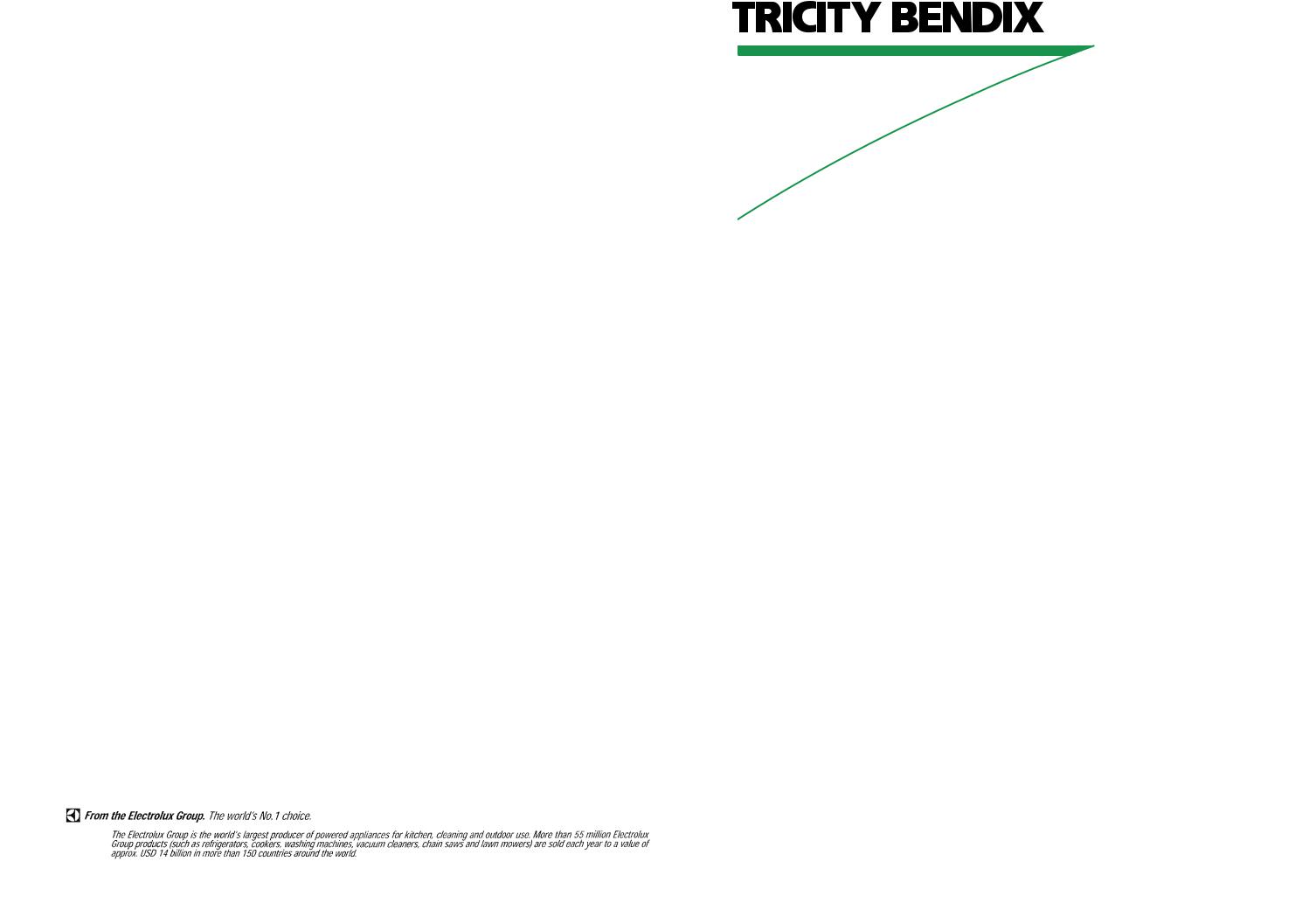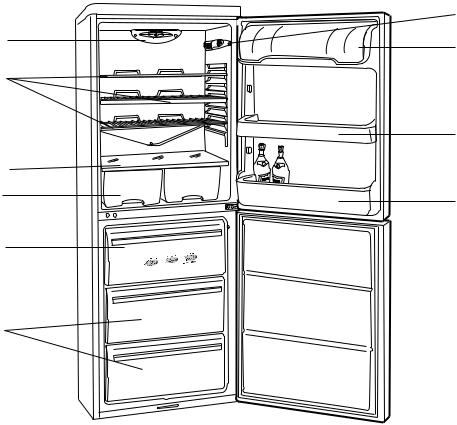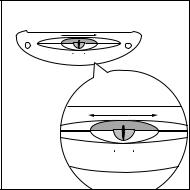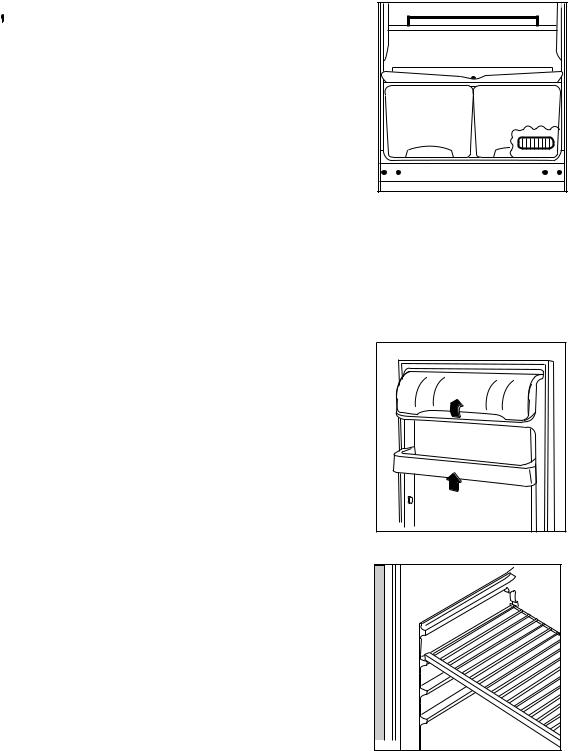Tricity Bendix TB 112 FF User Manual

OPERATING AND INSTALLATION
INSTRUCTIONS
FRIDGE-FREEZER
TB 112 FF
2222 048-41

IMPORTANT SAFETY INFORMATION
It is most important that this instruction book should be retained with the appliance for future reference. Should the appliance be sold or transferred to another owner, or should you move house and leave the appliance, always ensure that the book is left with the appliance in order that the new owner can get to know the functioning of the appliance and the relevant safety information.
This information has been provided in the interest of safety. You MUST read it carefully before installing or using the appliance.
Installation
¥This appliance is heavy. Care should be taken when moving it.
¥It is dangerous to alter the specifications or attempt to modify this product in any way.
¥Care must be taken to ensure that the appliance does not stand on the electrical supply cable. Important: if the supply cable is damaged, it must be replaced by a special cable available from the manufacturer or its service agent.
¥Any electrical work required to install this appliance should be carried out by a qualified electrician or competent person.
¥Parts which heat up should not be exposed. Whenever possible, the back of the appliance should be close to a wall but leaving the required distance for ventilation as stated in the installation instructions.
¥The appliance should be left for 2 hours after installation before it is turned on, in order to allow the refrigerant to settle.
Child Safety
¥Do not allow children to tamper with the controls or play with the product.
¥Keep all packaging well away from children.
During Use
¥This appliance is designed for domestic use only, specifically for the storage of edible foodstuffs only.
¥Frozen food must NOT be re-frozen once it has thawed out.
¥Do not place carbonated or fizzy drinks in the freezer.
¥Do not remove items from the freezer if your hands are damp/wet, as this could cause skin abrasions or frost/freezer burns.
¥Ice lollies can cause Ôfrost/freezer burnsÕ if consumed straight from the freezer.
¥ManufacturersÕ storage recommendations should be strictly adhered to. Refer to relevant instructions.
¥The cooling plate or refrigerated freezer shelves in this appliance contain channels through which the refrigerant passes. If these are punctured this will cause substantial damage to the appliance and result in food loss. DO NOT USE SHARP INSTRUMENTS to scrape off frost or ice. Under NO circumstances should solid ice be forced off the lining or shelves. Solid ice should be allowed to thaw, when defrosting the appliance. See Defrost Instructions.
Maintenance and Cleaning
¥Switch off and unplug the appliance before carrying out any cleaning or maintenance work.
Servicing
¥This product should be serviced by an authorised engineer and only genuine spare parts should be used.
¥Under no circumstances should you attempt to repair the machine yourself. Repairs carried out by inexperienced persons may cause injury or serious malfunctioning. Refer to your local Service Force Centre and always insist on genuine spare parts.
At the end of the Appliance Life
¥When disposing of your appliance, use an authorised disposal site.
¥Remove the plug and ensure that any locks or catches are removed, to prevent young children being trapped inside.
2
CONTENTS
Instructions for the User
Important Safety Information |
2 |
Description of the Appliance |
4 |
Operation |
5 |
Before use |
5 |
To start the Appliance |
5 |
Setting the temperature |
5 |
Use of an air circulation slider control |
5 |
Fresh food refrigeration |
5 |
Positioning the door shelves |
6 |
Positioning the inner shelves |
6 |
The freezer compartment |
7 |
Freezing fresh food |
7 |
Frozen food storage |
7 |
Thawing |
7 |
Making Ice cubes |
7 |
Normal Operating Sounds |
8 |
Health and Safety Guidelines |
9 |
Maintenance and Cleaning |
10 |
Internal cleaning |
10 |
External cleaning |
10 |
When the appliance is not in use |
10 |
Changing the light bulb |
10 |
Defrosting |
10 |
Something Not Working |
11 |
Service and Spare Parts |
12 |
Customer Care |
12 |
Guarantee Conditions |
15 |
Instructions for the
Installer
Technical Specification |
16 |
Installation |
17 |
Positioning |
17 |
Rear Spacers |
17 |
Electrical Connection |
18 |
Door Reversal |
19 |
3

DESCRIPTION OF THE APPLIANCE
J |
COOL FLOW SYSTEM |
I
H
G
F
E
A- Thermostat control for fridge and freezer compartments
B- Dairy compartment
C- Storage shelf
D- Bottle storage shelf
E- Freezing/Storage compartments
F- Freezing fresh food compartment
G- Salad drawers
H- Glass shelf
I- Wire shelves
J- Air circulation slider control
A B
C
D
4

OPERATION
Before using
Remove all securing tapes. Wash inside the appliance with lukewarm water and bicarbonate of soda (5 ml to 0.5 litre of water).
Do not use soap or detergent as the smell may linger. Dry thoroughly.
To Start the Appliance
Allow the appliance to stand for 2 hours after installation.
Plug in the appliance and switch on at the mains supply. Turn the thermostat control to a midway setting (3-4) and adjust the slider control, situated on the back wall of the fridge section, to a midway position between ÒcoldÓ and ÒcoldestÓ. Leave the appliance for approximately 4 hours for the correct temperature to be reached before placing food inside.
To switch off the appliance turn the thermostat control to position ÒOÓ
Setting the temperature
The temperature inside the appliance is regulated by a thermostat with 6 temperature positions and an ÒOFFÓ (O) position.
Position 1 = minimum coldness Position 6 = maximum coldness
Turn the thermostat dial to the required position.
The intermediate position is usually the most suitable (3-4).
The thermostat control regulates the temperature both within the fridge and the freezer compartment. The thermostat setting can vary as the temperature inside the appliance depends on the following factors:
Ðroom temperature
Ðhow often the door is opened
Ðhow much food is stored
Ðposition of the appliance
Use of an air circulation slider control - COOL FLOW SYSTEM
Your appliance has an air circulation slider control situated at the rear of the fridge compartment, which controls the amount of cold air circulated through the fridge compartment.
When the ambient temperature is between 10¡C and 16¡C, the slider control should be in the ÒcoldÓ position.
When the ambient temperature is above 16¡C the slider control should be midway between ÒcoldÓ and ÒcoldestÓ.
When the ambient temperature is very high (i.e. hot summer days) position the slider control to ÒcoldestÓ.
COLD |
COLDEST |
|
COOL FLOW SYSTEM |
|
|
|
COLD |
COLDEST |
|
COOL FLOW SYSTEM |
|
D757 |
|
|
Fresh food refrigeration
To obtain the best performance, do not store warm food or evaporating liquids in the refrigerator; cover or wrap the food, particularly if it has a strong flavour.
Do not cover the shelves with any protective material, such as paper, cardboard or plastic, which may obstruct the air circulation.
To help you use your refrigerator correctly, here are some more useful hints:
Raw meat (beef, pork, lamb & poultry or chicken): wrap in polythene bags and place on the glass shelf above the salad drawers.
Meat can only be stored safely in this way for one or two days at the most.
Fruit & vegetables: these should be thoroughly cleaned and placed in the salad drawers.
Butter & cheese: these should be placed in special airtight containers or wrapped in aluminium foil or polythene bags to exclude as much air as possible.
Milk bottles: these should have a cap and should be stored in the bottle rack on the door.
5

 Warning
Warning
If using the appliance with the salad drawer removed, please ensure the vent in the back wall of the appliance is not obstructed.
D756
Positioning the door shelves
The door shelves can be easily removed for cleaning. Gently ease the shelf in the directions shown.
Adjustment of the door shelves can be made to accommodate varying heights of bottles and other containers. Store light items such as small cartons and jars on the door shelves. The bottle shelf can be used for the storage of heavier bottles.
Positioning the inner shelves
The walls of the refrigerator have runners so that shelves can be positioned as desired.
D758 |
D040 |
6
